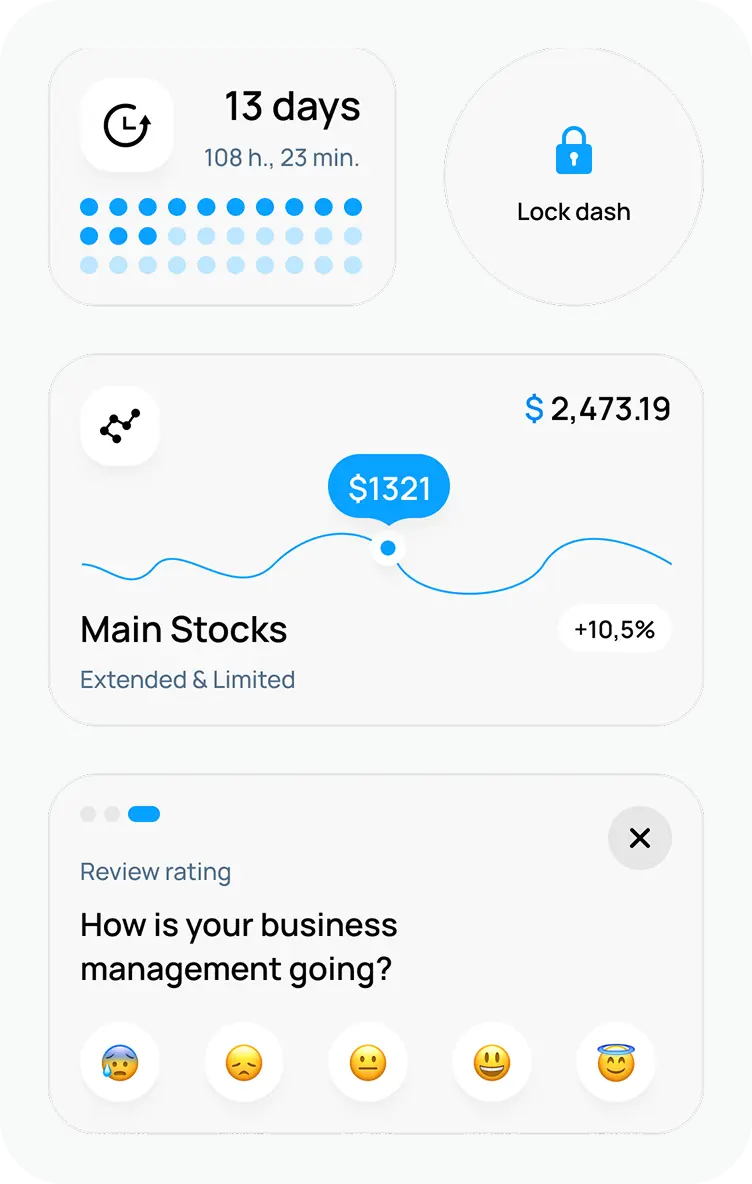Top 7 React Alternatives: When They Actually Make Sense
April 22, 2025•11 min read

I hope you enjoy reading this post. If you want us to do your frontend development or design, click here.
Author: Alex Vasylenko | Founder of The Frontend Company


When the idea to write about React alternatives came to me, my first thought was: "Wait, why would anyone even want to switch from React?"
It's one of the most robust, battle-tested, and widely supported frontend solutions on the planet. In fact, 40% of professional developers use React more than any other framework.
Additionally, I couldn't immediately name a better framework off the top of my head.
But the deeper I went into research, the more I started seeing a pattern.
Article after article misleads readers that React is outdated, bloated, or bad for their project, providing a list of alternatives that only confuses them. They may start to search for something better than React, and whether they need it.
So, in this post, I will answer these questions, and you will completely understand if you need the React alternatives, which ones are the best, and in what cases they actually make sense.
Spoiler: Most of the time, they don't.
Why React Is So Good and Popular?
Before we jump into reviewing React alternatives, let's first understand why React is so good — and why it became so popular in the first place.
1. React Scales for Codebases and Teams
One of the biggest reasons React is so popular is how well it scales for your code and your team. React's component system lets developers break your UI into small, reusable parts. They can build a button once and use it everywhere.
But the real power shows up when your product and your team begin to grow. With React, multiple developers can work on different parts of the app at the same time without stepping on each other's code. That's a big deal when you're working with dozens of engineers.
⚡ No other frontend library handles scaling across large teams and massive codebases as well as React does.
And this is a reason why it's the go-to choice for companies like Meta, Netflix, and Shopify.
2. React Gives You Control
The second great thing about React is that it doesn't box you in. It gives developers the building blocks — and lets them decide how to use them.
You can choose tools for state management, routing, data fetching, styling — whatever fits your project. React doesn't force a specific setup, and that flexibility is exactly why so many teams love it.
Whether you're building a small app or a massive enterprise system, you can shape React to work the way you need it to.
⚡ React is still the #1 frontend library, used by over 40% of professional developers worldwide.
3. React Has a Big Community and Ecosystem
React's ecosystem and massive community let you move faster, write less boilerplate, and focus on building new features — not reinventing the wheel every time you need a dropdown, modal, or API call.
It has over 235,000 stars on GitHub, hundreds of thousands of Stack Overflow threads, and an endless number of tutorials, UI kits, boilerplates, and libraries built around it.
That kind of support doesn't just make life easier — it lowers risk. Whatever problem you meet, someone has already faced it, solved it, and likely shared the solution.
React isn't just a library — it's an entire ecosystem that's been hardened in production across thousands of teams and use cases.
4. React Is a Default in the Frontend
ReactJS development services are a default in nearly every company that mentions "frontend." Most developers work with it, and many start their careers with this UI library.
For companies, that means one thing: it's easy to hire. You don't need to train new team members from scratch. They already understand components, JSX, hooks, and the ecosystem.
And because React follows shared conventions, it's easier to scale teams without constantly aligning on how things should be done. Everyone speaks the same language.
When you choose React, you're choosing predictability — not just in how your app behaves but in how quickly your team can grow and contribute.
Need Fast, Scalable, and User-Friendly Web Applications on React?
Why You Don't Need React Alternatives
So now that we've looked at why React is so popular and what makes it such a solid choice, why do you even need alternatives?
If your product is already built with React, you should think very carefully before a switch, as it might do more harm than good.
React handles almost everything you could ask from a frontend library:
Complex user interfaces
Performance tuning and rendering optimizations
Server-side rendering
Mobile apps (via React Native)
A massive ecosystem of libraries and tools
It's flexible, proven, and has answers to nearly every challenge you'll face in a frontend project.
Most of the time, when people start exploring alternatives, it's not because React can't do the job — it's because they think there's a better solution or a new framework popped up promising something faster, lighter, or more “modern.” But that's not a reason to rewrite your entire frontend.
If you're researching what else is out there, great. It is part of a job. But in 9 out of 10 cases, React will still be the best solution for your project.
That said, after digging deep into this topic, I put together a list of specific cases where moving away from React makes sense.
Check them below.
When Does it Make Sense to Move Away from React?
Here are a few specific scenarios where moving away from React might be worth it:
1. You Need Extreme Performance
React is fast enough for most applications. But when you're building something that constantly updates, like real-time dashboards, trading platforms, monitoring systems, or advanced visualizations, that “fast enough” ceiling starts to show.
The reason is React's virtual DOM.
Every time the state changes in React, it re-renders the entire component, compares it to the previous render using the virtual DOM, and then updates the real DOM based on the diff. This adds overhead, especially when updates happen frequently or across large trees of elements.
In high-frequency scenarios — like animating thousands of data points or updating a UI 60+ times per second — React can fall behind, introducing lag or frame drops.
So, if you're building:
A financial dashboard with live data updates
A real-time collaborative editor
A complex canvas-based UI or data visualization tool
A control panel for IoT or streaming data
...then you may hit React's limits sooner than you’d like.
In those edge cases, some frameworks can deliver smoother performance with less tuning and fewer workarounds. We will discuss them later.
2. You Need Simpler State Management
React gives you a lot of power, but sometimes, it makes simple things feel complicated.
As your app grows, managing how the UI responds to changes like clicks or new data becomes harder. Developers often need to write extra logic to keep things in sync.
But this only becomes a real problem if you’re dealing with a large, fast-changing app where:
You’re constantly adding features
Multiple developers are working on the same parts of the app
Small changes break things unexpectedly
Debugging takes too long
If your team is spending more time managing the UI than building actual product features, that’s when simpler state management isn’t just nice to have. It’s a reason to switch.
3. You Need More Structure
React gives you flexibility, and that’s a big reason why so many developers love it. But that flexibility also means you have to make a lot of decisions yourself: how to manage state, how to structure your app, how to handle data, routing, testing, and more.
That works well when you have an experienced team that prefers to build things their own way.
But it can become a problem when:
Your team is growing fast
You’re onboarding a lot of new developers
You need everyone to follow the same architecture
Projects start to drift in different directions
If your frontend is turning into the Wild West — with every team doing things differently — you need something that gives you conventions, structure, and a defined way of building apps out of the box.
Switching from React to a more structured framework can help your team stay consistent and spend less time figuring out how things should be built.

Transform your UI for peak performance!
🔹
Unlock seamless, high-performance frontend solutions tailored to your business.
🔹
Get an interface that outshines competitors and delights your users.
7 Best Alternatives to React
Now that we’ve looked at the reasons why someone might consider moving away from React, let’s get into the actual React alternatives.
Each of the options below solves a specific pain point we discussed earlier — whether it’s about performance, simpler state management, or stronger structure.
None of them are "React killers." But in the right situation, with the right team and the right product, they might give you an advantage.
1. Angular – Gives You More Structure
If your team needs a strict structure and clear rules, Angular delivers that out of the box.
Unlike React, which gives you a flexible toolkit and leaves the architecture up to you, Angular is a structured framework. It tells developers how to build, where to put things, how to manage state, how to fetch data, and how to write tests within a consistent setup.

Angular’s two-way data binding, dependency injection, and modular architecture provide a strong foundation for creating well-structured and maintainable user interfaces.
This is a huge advantage for:
Large teams with many developers
Projects that require clear conventions
Companies that value maintainability over flexibility
Teams onboarding junior developers who need more guidance
In React, two teams might build the same feature in completely different ways. In Angular, they’ll follow the same structure by default — because the framework enforces it.
If your project is starting to feel like a patchwork, or if you’re spending more time debating architecture than building features, Angular’s structure is exactly what you need.
It comes at the cost of some flexibility, but in return, you get consistency, tooling, and strong architectural discipline from day one.
2. Svelte – Gives You Simpler State Management
If managing state in React feels like too much overhead, Svelte offers a different approach and keeps things simple.
In React, developers often need to combine multiple tools to make the UI responsive to changes, including hooks, context, effect dependencies, and external libraries. It works, but it adds complexity, especially as your app grows.

Svelte solves this by compiling your code into highly optimized JavaScript at build time instead of relying on a virtual DOM. There is no need to wrap it in state hooks or manage dependencies. It’s all about making things simple and efficient so you can build high-performance applications without getting slowed down by extra challenges.
This makes Svelte a strong option when:
Your team is tired of boilerplate and workarounds
You want less code to do the same job
You’re building a product that’s growing fast and changing often
You want junior devs to contribute without breaking things
Svelte also includes routing, transitions, scoped styles, and basic state management out of the box.
If your team is spending time figuring out how to make the UI behave rather than building features, Svelte might offer a much smoother ride.
3. Solid – Gives You Extreme Performance
If your app needs to update the UI fast and frequently, and React isn’t keeping up, Solid offers a reactive programming model that is both powerful and straightforward.

React updates components by re-rendering them and using the virtual DOM to figure out what changed. That’s efficient enough for most apps. But in real-time dashboards, data-heavy interfaces, or apps that push updates multiple times per second, it adds noticeable overhead.
Solid is a great React alternative as it skips the virtual DOM entirely and uses fine-grained reactivity. When something changes, only the exact piece of the DOM that depends on that value is updated. That means zero re-renders, zero diffing, and much faster updates.
You’ll see the biggest gains if you’re building:
Real-time monitoring or trading interfaces
Heavy visualizations with lots of states
Apps with high interaction frequency (e.g. forms, editors, maps)
Performance-sensitive products with animation or live data
What’s also great — Solid’s syntax looks and feels like React. You use JSX, components, and hooks without the re-renders and performance tuning that React often requires.
If you’ve already tried optimizing your React app and it’s still not responsive enough, Solid gives you a similar developer experience with much better performance.
4. Qwik – Gives You Extreme Performance (on First Load)
Most frameworks focus on runtime performance after the app has loaded. Qwik focuses on something else: making your app interactive as fast as possible, even before the full JavaScript bundle is loaded.

React can do server-side rendering through tools like Next.js, but it still requires hydration — a process where the browser downloads and re-executes JavaScript to make the page interactive.
On large pages, this can delay user interaction and hurt metrics like Time to Interactive and Core Web Vitals, which are crucial for SEO.
Qwik uses a concept called resumability — instead of hydrating the app on the client, it ships HTML that’s already interactive.
This is a huge win if:
You’re building a content-heavy site or blog
You care about SEO and fast Time to Interactive
You’re optimizing for mobile users and low-bandwidth environments
Your business depends on performance metrics (e.g. e-commerce, marketing)
Qwik isn’t just fast at runtime — it’s fast before runtime even begins. If you’ve pushed React/Next.js to the limit and still can't hit the performance numbers you need, Qwik is built specifically for that.
5. Flutter – Gives You More Structure and Cross-Platforming
If you’re building both web and mobile apps and want one codebase, one UI system, and one consistent developer experience, pick Flutter as a React alternative.

Unlike React, where you choose your stack piece by piece, Flutter gives you a framework with strong conventions. UI is built using pre-defined widgets, logic follows clear patterns, and everything — from layout to animation — behaves predictably across platforms.
This level of structure is a big advantage when:
You’re building both mobile and web versions of the same product
You want design consistency across devices
You need control over how every pixel looks and moves
You don’t want to maintain separate teams or codebases
Flutter doesn’t rely on the browser’s DOM at all — it uses its own rendering engine, which gives you pixel-perfect control but also means you step outside of typical web standards. It’s not ideal for SEO-heavy websites, but for apps, dashboards, and internal tools, it can be a solid choice.
If React’s flexibility is slowing your team down or creating inconsistencies between platforms, Flutter’s all-in-one approach might be what you need to stay focused and structured.
6. Vue – Gives You Simpler State Management
Vue is a brilliant React alternative if you are looking for a flexible framework with a reactivity model that is more straightforward than React’s. You don’t deal with hooks or dependency arrays — components react to data changes automatically, with less boilerplate.

It also includes many built-in features React doesn’t, like transitions, scoped styles, and built-in state handling — which means fewer external dependencies and more consistent code across teams.
Vue makes sense if:
Your app is growing, and you want to keep state logic clean and easy to debug
You want reactivity without the mental overhead of React’s hooks
Your team prefers convention over configuration, but still wants flexibility
If React’s state handling feels like a puzzle every time you build a new feature, Vue offers a simpler and more predictable way forward.
7. Inferno – Gives You Extreme Performance (and you can stay close to React)
If you love React’s API but need more raw performance, Inferno is one of the fastest virtual DOM libraries available.

It was built from the ground up with performance in mind — smaller bundle size, faster renders, and quicker updates. Unlike Svelte, which introduces new concepts, Inferno keeps a React-like syntax and component model, making it easier to adopt if your team already knows React.
Inferno makes sense when:
You want to squeeze more performance without changing your development model
You're building embedded apps, kiosk UIs, or performance-critical frontends
You want to keep JSX and class components but cut the overhead
It won’t give you simpler state handling or more structure — it’s still “just the view” like React — but if you want speed without the learning curve, Inferno is a strong choice.
Table of React Alternatives
Here's a quick summary of each alternative to React:
Alternative | Strength Over React | Best For |
|---|---|---|
Angular | More Structure | Large teams, enterprise-scale apps |
Svelte | Simpler State Management | Teams are tired of boilerplate, fast-moving projects |
SolidJS | Extreme Runtime Performance | Real-time UIs, dashboards, high-frequency updates |
Qwik | Extreme Performance (First Load) | SEO-focused, content-heavy sites, mobile users |
Flutter | More Structure & Cross-Platform | Teams building for web + mobile with one codebase |
Vue | Simpler State Management | Apps that need easy reactivity and less boilerplate |
Inferno | Extreme Runtime Performance (React-Like) | Embedded apps, performance-critical views |
Conclusion
For CTOs and engineering leaders, the decision to deviate from React should be driven by clear needs and careful cost-benefit analysis. Your company must have several good reasons to switch from React, as it is an expensive operation that will change not only your technical vector but also your overall strategy.
Sometimes, the best solution is to stick with React but adopt new libraries or techniques within it. For example, using a compiled component library or offloading work to web workers.
If you’re starting a new project, building something that React truly struggles with, or your team has a very specific use case, exploring these alternatives can absolutely make sense. But go into it with clear intent, not because someone online told you React is “outdated.”
⚡React is still the most versatile, scalable, and widely supported solution in frontend development.
But as always, the best tool is the one that fits your product, your people, and your mindset.

Unlock the full potential of your product

Boost customer retention & satisfaction

Become more competitive on the market

Move to the latest technologies stacks

Improve usability & visual appeal
FAQ

Alex Vasylenko is the founder of The Frontend Company, DBC and several other successful startups. A dynamic tech entrepreneur, he began his career as a frontend developer at Deloitte and Scandinavia's largest banking company. In 2023, Alex was honored as one of 'Top 10 Emerging Entrepreneurs' by USA Today.
RATE
Rate this article please
This will help us provide more useful information.
743 ratings, average 4.99 out of 5
